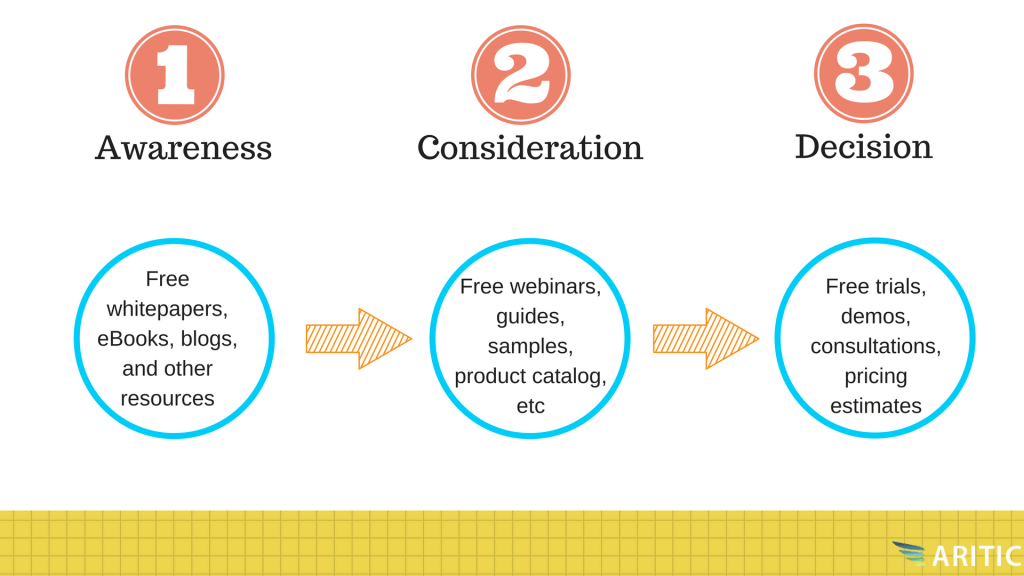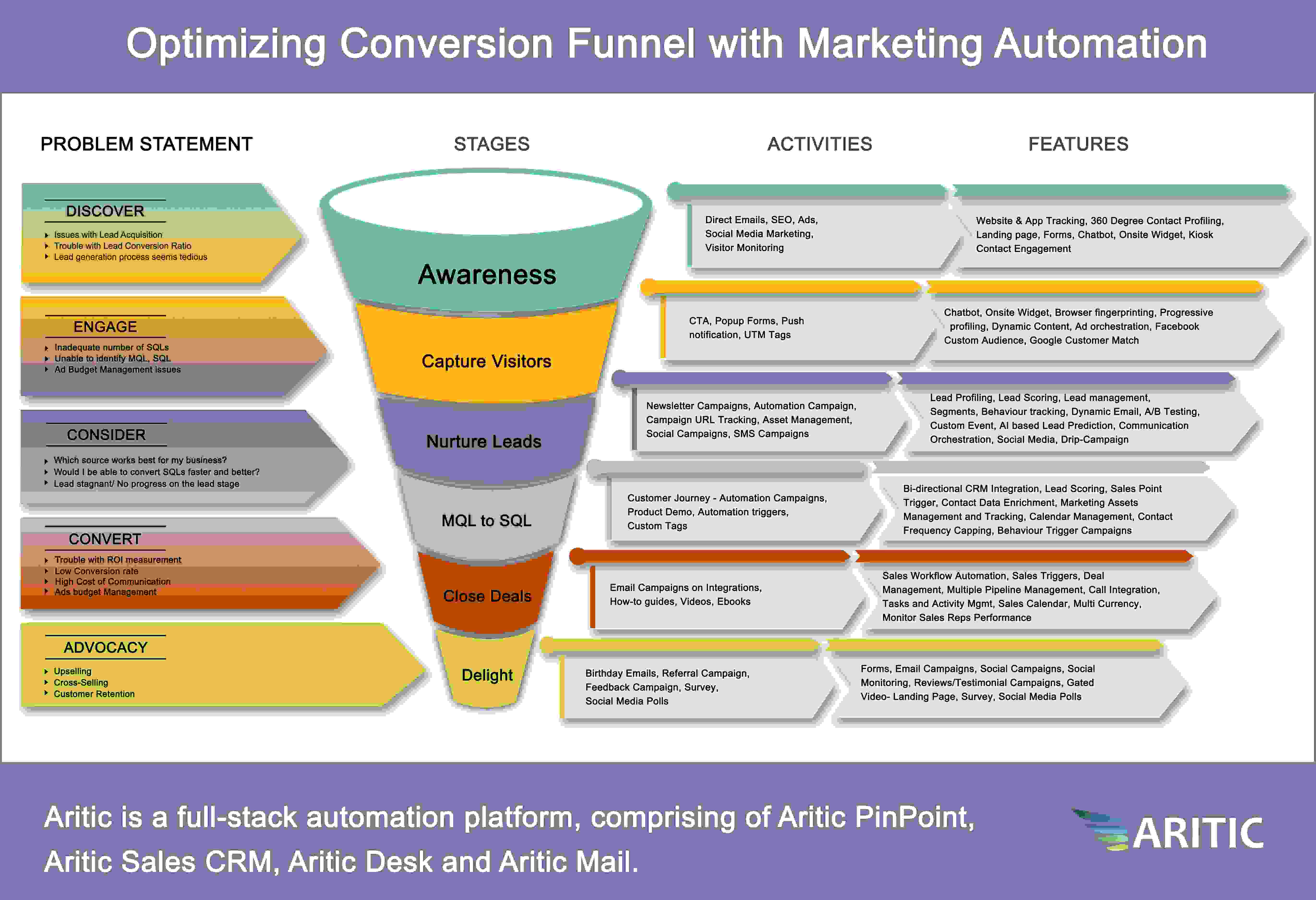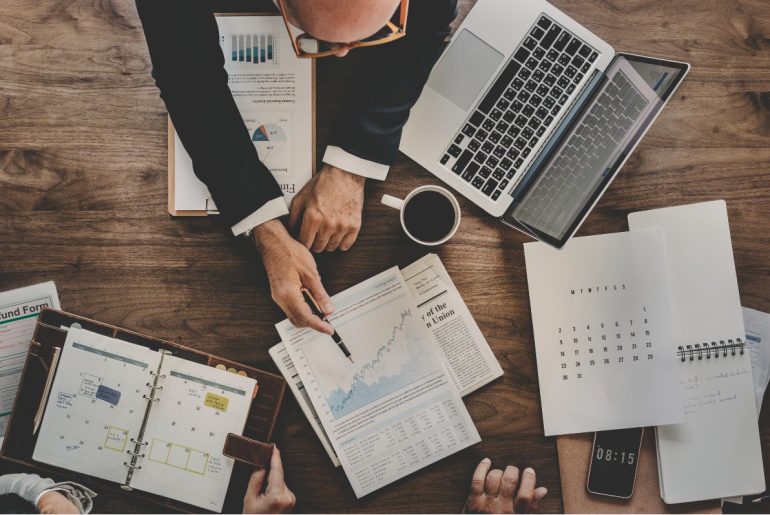Marketing automation can optimize the conversion funnel by streamlining lead generation, nurturing, and scoring, as well as allowing for segmentation and personalization. It can help to provide a more targeted and personalized experience to leads and customers and enable retargeting to those who have shown interest but not yet converted. Marketing automation tool used for optimizing the conversion funnel, increasing the likelihood of successful conversion and driving business growth.
Jump Directly to
1 . Optimize your conversion funnel with Aritic PinPoint
2. Important Conversion Funnel Metrics
3. Understanding the Conversion Funnel
A marketing automation tool can help you put your efforts in place and trigger higher conversion rates. However, if you believe a conversion funnel begins at the SQL (sales qualified) stage then you are wrong. Share on XIn fact, a conversion funnel begins right when a stranger comes in contact with your brand, and continues until it has become a customer and an advocate.
Optimize your conversion funnel with Aritic PinPoint
Rather than randomly stating that a marketing automation tool can help you trigger your conversion funnel, we will show you exactly what features of a marketing automation tool actually helps you (with direct reference to, of course, Aritic PinPoint).
Important Conversion Funnel Metrics
Before we dig into understanding a conversion funnel, here are three important metrics that you need to measure your lead generation funnel:
- Interaction metrics: This comprises how your leads are engaging with your campaigns and your content. Metrics like website visits, page visits, click-through rates, unsubscription rates are measures. This metric is measured throughout the conversion funnel but they are actually mere pointers of success.
- Performance metrics: This measures the effectiveness of your campaigns. Metrics that indicate whether a lead is an MQL or SQL or sales opportunity are used.
- Revenue metrics: Lastly, this involves measuring the valuation and return on your campaigns against your investments. It includes customer acquisition cost, customer lifetime value, total income generation, churn rate, and conversion rate.
Understanding the Conversion Funnel
P.S. This funnel is more appropriate for a B2B business.

The conversion funnel begins right from the moment a stranger gets in touch with your brand. A user does not directly search for a brand unless they are familiar with it or have a reference from someone they know.
It always begins with the DISCOVER stage – a stage where the user is only starting to know about your brand.
Ideally, the conversion funnel is divided into five main stages following an ideal customer journey:
Still Not an User of Aritic PinPoint Automation?
- Discover
- Engage
- Consider
- Convert
- Advocacy
To understand how the funnel works, we will simultaneously look at the funnel from both the user’s and the marketer’s points of view.
1. Conversion funnel stage one
It begins when the user understands that it has a problem but is not aware of what it is. It may have some symptoms but is unclear of its exact problem statement. This is when it starts using keywords or phrases to describe its problem and make a search.
Marketers understand what kind of keywords ideal users may be using. They target such keywords and phrases (along with their semantic variations) so that when the user makes a search, it finds their brand.
This stage of knowing about the problem and also getting aware of various solution providers is called AWARENESS.
2. Conversion funnel stages two and three
Now that the user is aware of what problem it has, it starts looking for probable solutions. This is the engagement phase which quickly passes on to the consideration phase.
However, it is during the engagement phase that the user tries to analyze which solution provider is best suited.
Again, the engagement stage is exactly where marketers use forms or landing pages or newsletter campaigns, or social media ads to capture visitors and convert them into leads. By monitoring their browsing patterns, it is easier to retarget them with relevant campaigns and get them onboard.
Once a visitor converts into a lead, it enters the CONSIDERATION stage. Once a lead enters the funnel, various automation campaigns are used to nurture them. Lead profiling is done, behaviors are monitored and lead scoring is used to identify whether the lead is progressing or not.
3. Conversion funnel stage four and five
With effective lead nurturing campaigns, the lead gains enough knowledge to draw comparisons and make a final decision. Marketers use comparison charts, market insights, use cases, and testimonials to convince leads to decide in their favor. By showing explicitly how a brand can be useful and can add value, marketers ensure that the lead gets converted.
When lead scoring indicates that a lead has become HOT, it means it has become a sales opportunity i.e. a sales qualified lead. Immediately, sales-based automation campaigns are triggered that may include product demos, videos, or ebooks to help them get onboard faster. Deal values are measured and sales pipelines are created.
When the lead hits the purchase button, they get CONVERTED.
However, the conversion funnel does not end with the CONVERT stage. In fact, the conversion is just halfway the job done. Retaining your customers is a big task because these customers will go on to refer to new users in the future.
Using email campaigns, offers, social monitoring, gated video, etc. marketers ensure that the customer has a smooth onboarding and starts using the product. Activities to ensure that the customer keeps renewing their subscription are mandatory.
A delighted customer makes way for brand ADVOCACY wherein they refer to new users.
Referring to new users means the conversion funnel begins again from stage one.
Below is an infographic that lists down the problem statements, stages, activities, and features corresponding to each other. Use this conversion funnel infographic as a guide for your next conversion strategy.

⭐ What is a conversion funnel?
The conversion funnel determines the different stages of the buyer’s journey through internet advertising and transforming them into a sale.
⭐ How to optimize the conversion funnel?
Here are steps to optimize the conversion funnel:
a) Find Customer Segmentation
b) Fix the drawbacks
c) Remove steps from the funnel
⭐ How to create a conversion funnel?
Steps for creating a sales conversion funnel:
a) Plan out the buying process
b) Establish your conversion goals in Google Analytics
c) Create engaging and relevant content
d) Scrutinize leaks in the conversion funnel
e) Focus on optimizing the conversion rate
⭐ Why is conversion funnel required?
A conversion funnel is required to visualize the workflow of potential leads before converted into loyal customers.
⭐ What is funnel conversion rate?
Funnel conversion rate determines the movement rate of leads through the marketing funnel and understands the lead’s journey for pushing them through the end funnel.
⭐ How do you build a powerful marketing funnel?
A marketing funnel is a series of steps that you take online to get prospective customers from the general public into your sales funnel. There are many different ways to do this. You can offer a free trial, or give away a downloadable report for people to read and then contact you through your website if they want more information, etc. Define these stages in advance so it’s easier to track what’s going on and see where there are opportunities for improvement.
⭐ How can an eCommerce conversion funnel be improved?
Improving your eCommerce conversion funnel starts with identifying the problem areas. Knowing where you need to focus will help you to prioritize and be more effective. If you’re having trouble converting visitors into customers, it’s worth taking a closer look at your purchase process. It’s not always as simple as merely adding a few extra fields to the checkout page.
⭐ What is conversion in the marketing funnel?
Conversion is the action a user takes after interacting with your website or advertisement. Conversion can be tracked through leads, sales, or other metrics depending on what stage of the marketing funnel you are looking at.




1 Comment
Conversion funnels are vital to the success of any business, especially e-commerce. The ultimate goal of a conversion funnel is to get customers to purchase products or services.